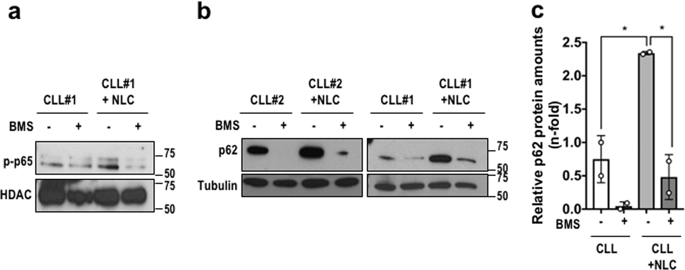当前位置:
X-MOL 学术
›
Cell Death Differ.
›
论文详情
Our official English website, www.x-mol.net, welcomes your
feedback! (Note: you will need to create a separate account there.)
NF-κB-p62-NRF2 survival signaling is associated with high ROR1 expression in chronic lymphocytic leukemia.
Cell Death and Differentiation ( IF 13.7 ) Pub Date : 2020-01-28 , DOI: 10.1038/s41418-020-0496-1 Elsa Sanchez-Lopez 1 , Emanuela M Ghia 2 , Laura Antonucci 1 , Natasha Sharma 1 , Laura Z Rassenti 2 , Jinyi Xu 3 , Beicheng Sun 4 , Thomas J Kipps 2 , Michael Karin 1
Cell Death and Differentiation ( IF 13.7 ) Pub Date : 2020-01-28 , DOI: 10.1038/s41418-020-0496-1 Elsa Sanchez-Lopez 1 , Emanuela M Ghia 2 , Laura Antonucci 1 , Natasha Sharma 1 , Laura Z Rassenti 2 , Jinyi Xu 3 , Beicheng Sun 4 , Thomas J Kipps 2 , Michael Karin 1
Affiliation

|
Progression of chronic lymphocytic leukemia (CLL) and resistance to therapy are affected by tumor microenvironmental factors. One such factor is B-cell activating factor (BAFF), a cytokine that is produced mainly by nurse-like cells (NLC) and enhances CLL cells survival and modulates response to therapy. In CLL cells, BAFF activates NF-κB signaling, but how NF-κB supports CLL survival is not entirely clear. In this study we show that BAFF induces accumulation of the signaling and autophagy adaptor p62/SQSTM1 in a manner dependent on NF-κB activation. p62 potentiates mTORC1 signaling and activates NRF2, the master regulator of the anti-oxidant response. We found that expression of NRF2 target genes, such as NAD(P)H quinone oxidoreductase 1 (NQO1), is particularly enriched in CLL cells with high ROR1 surface expression (ROR1Hi). ROR1Hi CLL cells with elevated NQO1 expression exhibit resistance to drugs that induce ROS accumulation, such venetoclax. However, such cells are more sensitive to compound 29h, a pro-drug that only becomes active after being metabolized by NQO1. Accordingly, 29h sensitizes high NQO1 CLL cells to venetoclax. Collectively, our study unravels a previously unknown signaling network through which the NF-κB-p62-NRF2 axis protects ROR1-high CLL cells from ROS-inducing therapeutics.
中文翻译:

NF-κB-p62-NRF2 存活信号与慢性淋巴细胞白血病中的高 ROR1 表达相关。
慢性淋巴细胞白血病 (CLL) 的进展和对治疗的抵抗受到肿瘤微环境因素的影响。其中一个因子是 B 细胞激活因子 (BAFF),这是一种主要由护士样细胞 (NLC) 产生的细胞因子,可提高 CLL 细胞的存活率并调节对治疗的反应。在 CLL 细胞中,BAFF 激活 NF-κB 信号传导,但 NF-κB 如何支持 CLL 存活尚不完全清楚。在这项研究中,我们表明 BAFF 以依赖于 NF-κB 激活的方式诱导信号传导和自噬接头 p62/SQSTM1 的积累。p62 增强 mTORC1 信号并激活 NRF2,这是抗氧化反应的主要调节器。我们发现 NRF2 靶基因的表达,如 NAD(P)H 醌氧化还原酶 1 (NQO1),在具有高 ROR1 表面表达 (ROR1Hi) 的 CLL 细胞中特别丰富。NQO1 表达升高的 ROR1Hi CLL 细胞对诱导 ROS 积累的药物(如 venetoclax)表现出抗性。然而,这些细胞对化合物 29h 更敏感,这是一种前药,只有在被 NQO1 代谢后才会变得活跃。因此,29 小时使高 NQO1 CLL 细胞对 venetoclax 敏感。总的来说,我们的研究揭示了一个以前未知的信号网络,NF-κB-p62-NRF2 轴通过该网络保护 ROR1 高的 CLL 细胞免受 ROS 诱导疗法的影响。
更新日期:2020-01-28
中文翻译:

NF-κB-p62-NRF2 存活信号与慢性淋巴细胞白血病中的高 ROR1 表达相关。
慢性淋巴细胞白血病 (CLL) 的进展和对治疗的抵抗受到肿瘤微环境因素的影响。其中一个因子是 B 细胞激活因子 (BAFF),这是一种主要由护士样细胞 (NLC) 产生的细胞因子,可提高 CLL 细胞的存活率并调节对治疗的反应。在 CLL 细胞中,BAFF 激活 NF-κB 信号传导,但 NF-κB 如何支持 CLL 存活尚不完全清楚。在这项研究中,我们表明 BAFF 以依赖于 NF-κB 激活的方式诱导信号传导和自噬接头 p62/SQSTM1 的积累。p62 增强 mTORC1 信号并激活 NRF2,这是抗氧化反应的主要调节器。我们发现 NRF2 靶基因的表达,如 NAD(P)H 醌氧化还原酶 1 (NQO1),在具有高 ROR1 表面表达 (ROR1Hi) 的 CLL 细胞中特别丰富。NQO1 表达升高的 ROR1Hi CLL 细胞对诱导 ROS 积累的药物(如 venetoclax)表现出抗性。然而,这些细胞对化合物 29h 更敏感,这是一种前药,只有在被 NQO1 代谢后才会变得活跃。因此,29 小时使高 NQO1 CLL 细胞对 venetoclax 敏感。总的来说,我们的研究揭示了一个以前未知的信号网络,NF-κB-p62-NRF2 轴通过该网络保护 ROR1 高的 CLL 细胞免受 ROS 诱导疗法的影响。











































 京公网安备 11010802027423号
京公网安备 11010802027423号